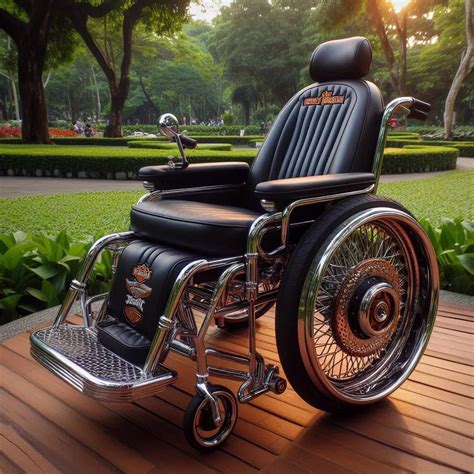The world of mobility has undergone a significant transformation in recent years, thanks to advancements in technology. High-tech wheelchairs have revolutionized the way people with disabilities move around, offering greater independence, comfort, and accessibility. In this article, we will explore 7 high-tech wheelchair features that are changing the game for individuals with mobility impairments.
1. Advanced Propulsion Systems

Traditional wheelchairs rely on manual propulsion, which can be tiring and straining for users. Advanced propulsion systems have transformed this aspect of mobility. High-tech wheelchairs now come equipped with power-assisted wheels, gear systems, and even artificial intelligence-powered propulsion. These features enable users to cover longer distances with minimal effort, making mobility more accessible and enjoyable.
Power-Assisted Wheels
Power-assisted wheels are a game-changer for individuals with mobility impairments. These wheels use sensors and motors to detect the user's movement and provide assistance when needed. This feature allows users to propel themselves with minimal effort, reducing fatigue and strain on the upper body.
Artificial Intelligence-Powered Propulsion
Some high-tech wheelchairs now incorporate artificial intelligence (AI) to optimize propulsion. AI-powered propulsion systems use sensors and machine learning algorithms to adjust the wheelchair's speed, torque, and direction based on the user's movement patterns. This feature enables users to navigate complex environments with ease and precision.
2. Smart Seating and Cushioning

Smart seating and cushioning have become a crucial aspect of high-tech wheelchairs. These features provide optimal comfort, support, and pressure relief for users. Advanced seating systems use sensors and algorithms to adjust the seat's shape, firmness, and temperature based on the user's body shape, weight, and movement patterns.
Pressure Relief Cushions
Pressure relief cushions are designed to redistribute pressure and prevent pressure sores. These cushions use advanced materials and technologies, such as gel or foam, to conform to the user's body shape. Some high-tech wheelchairs even incorporate dynamic pressure relief systems that adjust in real-time to prevent pressure sores.
3. Navigation and Control Systems

High-tech wheelchairs now come equipped with advanced navigation and control systems. These features enable users to navigate complex environments with ease and precision. Advanced control systems use sensors, GPS, and mapping technologies to provide users with accurate and real-time information about their surroundings.
Joystick-Free Control
Some high-tech wheelchairs now offer joystick-free control systems. These systems use sensors and algorithms to detect the user's movement patterns and adjust the wheelchair's speed, direction, and braking accordingly. Joystick-free control systems provide users with greater independence and flexibility.
4. Safety Features

Safety is a top priority for individuals with mobility impairments. High-tech wheelchairs now come equipped with advanced safety features, such as collision detection, automatic braking, and stability control. These features provide users with greater peace of mind and confidence when navigating complex environments.
Collision Detection
Collision detection systems use sensors and algorithms to detect potential collisions and alert the user. These systems can also automatically apply the brakes to prevent accidents.
5. Accessibility Features

High-tech wheelchairs now offer advanced accessibility features, such as curb climbing, stair navigation, and narrow passage navigation. These features provide users with greater independence and flexibility when navigating complex environments.
Curb Climbing
Curb climbing systems use sensors and algorithms to detect curbs and adjust the wheelchair's speed and angle accordingly. These systems enable users to navigate curbs with ease and precision.
6. Entertainment and Communication Systems

High-tech wheelchairs now come equipped with advanced entertainment and communication systems. These features enable users to stay connected, entertained, and informed on the go. Advanced entertainment systems use wireless connectivity, voice assistants, and high-resolution displays to provide users with an immersive experience.
Wireless Connectivity
Wireless connectivity systems enable users to connect to their smartphones, tablets, and laptops using Bluetooth, Wi-Fi, or cellular networks. These systems provide users with seamless connectivity and access to a wide range of apps, services, and content.
7. Customization and Personalization

High-tech wheelchairs now offer advanced customization and personalization options. These features enable users to tailor their wheelchairs to their specific needs, preferences, and lifestyles. Advanced customization systems use machine learning algorithms and data analytics to provide users with personalized recommendations and adjustments.
Machine Learning Algorithms
Machine learning algorithms use data analytics and user feedback to optimize the wheelchair's performance, comfort, and accessibility. These algorithms enable the wheelchair to adapt to the user's needs and preferences over time, providing a more personalized and effective mobility experience.






We hope this article has provided you with a comprehensive overview of the latest high-tech wheelchair features revolutionizing mobility. From advanced propulsion systems to customization and personalization options, these features are changing the game for individuals with mobility impairments. Whether you're looking for greater independence, comfort, or accessibility, there's a high-tech wheelchair out there that's right for you.
Share your thoughts on high-tech wheelchairs in the comments section below. How do you think these features can improve mobility and accessibility for individuals with disabilities?
